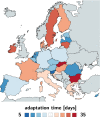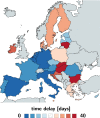The reproduction number of COVID-19 and its correlation with public health interventions
- PMID: 32836597
- PMCID: PMC7385940
- DOI: 10.1007/s00466-020-01880-8
The reproduction number of COVID-19 and its correlation with public health interventions
Abstract
Throughout the past six months, no number has dominated the public media more persistently than the reproduction number of COVID-19. This powerful but simple concept is widely used by the public media, scientists, and political decision makers to explain and justify political strategies to control the COVID-19 pandemic. Here we explore the effectiveness of political interventions using the reproduction number of COVID-19 across Europe. We propose a dynamic SEIR epidemiology model with a time-varying reproduction number, which we identify using machine learning. During the early outbreak, the basic reproduction number was 4.22 ± 1.69, with maximum values of 6.33 and 5.88 in Germany and the Netherlands. By May 10, 2020, it dropped to 0.67 ± 0.18, with minimum values of 0.37 and 0.28 in Hungary and Slovakia. We found a strong correlation between passenger air travel, driving, walking, and transit mobility and the effective reproduction number with a time delay of 17.24 ± 2.00 days. Our new dynamic SEIR model provides the flexibility to simulate various outbreak control and exit strategies to inform political decision making and identify safe solutions in the benefit of global health.
Keywords: COVID-19; Epidemiology; Machine learning; Reproduction number; SEIR model.
© Springer-Verlag GmbH Germany, part of Springer Nature 2020.
Figures











Update of
-
The reproduction number of COVID-19 and its correlation with public health interventions.medRxiv [Preprint]. 2020 Jul 7:2020.05.01.20088047. doi: 10.1101/2020.05.01.20088047. medRxiv. 2020. Update in: Comput Mech. 2020;66(4):1035-1050. doi: 10.1007/s00466-020-01880-8. PMID: 32676611 Free PMC article. Updated. Preprint.
References
-
- Alber M, Buganza TA, Cannon W, De S, Dura-Bernal S, Garikipati K, Karniadakis G, Lytton WW, Perdikaris P, Petzold L, Kuhl E. Integrating machine learning and multiscale modeling: perspectives, challenges, and opportunities in the biological, biomedical, and behavioral sciences. NPJ Dig Med. 2019;2:115. doi: 10.1038/s41746-019-0193-y. - DOI - PMC - PubMed
-
- Apple Mobility Trends. https://www.apple.com/covid19/mobility. Accessed on 25 June 2020
-
- Arenas A, Cota W, Gomez-Gardenes J, Gomez S, Granell C, Matamalas JT, Soriano-Panos D, Steinegger B (2020) Derivation of the effective reproduction number R for COVID-19 in relation to mobility restrictions and confinement. medRxiv 10.1101/2020.04.06.20054320.
Grants and funding
LinkOut - more resources
Full Text Sources
Miscellaneous
